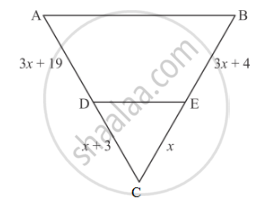Advertisements
Advertisements
प्रश्न
In ∆ABC, ∠A = 60°. Prove that BC2 = AB2 + AC2 − AB . AC.
उत्तर
In ΔABC, in which ∠A is an acute angle with 60°.

`sin 60^o = (CD)/(AC)=sqrt3/2`
`⇒ CD = sqrt3/2AC`.................(1)
`cose 60^o = (AD)/(AC)=1/2`
`⇒ AD = 1/2 AC`
Now apply Pythagoras' theorem in triangle BCD
`BC^2=CD^2+BD^2`
`= CD^2 +(AB-AD)^2`
`= (sqrt3/2AC)^2+AB^2+(1/2AC)^2-2AB1/2AC`
`=AC^2+AB^2-AB.AC`
Hence `BC^2=AB^2+AC^2-AB.AC`
APPEARS IN
संबंधित प्रश्न
What values of x will make DE || AB in the given figure?

There is a staircase as shown in the given figure, connecting points A and B. Measurements of steps are marked in the figure. Find the straight line distance between A and B.

State basic proportionality theorem and its converse.
State AAA similarity criterion.
If the areas of two similar triangles ABC and PQR are in the ratio 9 : 16 and BC = 4.5 cm, what is the length of QR?
In the given figure, PQ || BC and AP : PB = 1 : 2. Find\[\frac{area \left( ∆ APQ \right)}{area \left( ∆ ABC \right)}\]

If ∆ABC and ∆DEF are similar such that 2AB = DE and BC = 8 cm, then EF =
Two poles of height 6 m and 11 m stand vertically upright on a plane ground. If the distance between their foot is 12 m, the distance between their tops is
If ABC and DEF are similar triangles such that ∠A = 47° and ∠E = 83°, then ∠C =
∆ABC is an isosceles triangle in which ∠C = 90. If AC = 6 cm, then AB =
